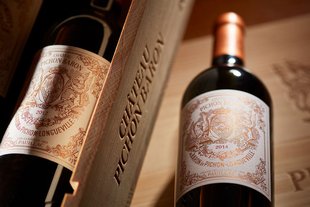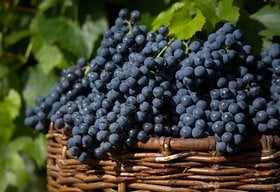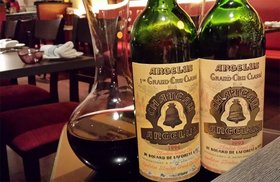The Chateau Pichon Longueville Estates (Wine Styles, Best Bottles 2025)
Chateau Pichon Longueville Baron and Pichon Comtesse de Lalande are two iconic estates in the celebrated Pauillac appellation of Bordeaux.
The two estates were classified as second growth (Deuxièmes Crus) in the Bordeaux Wine Official Classification of 1855 (Les Grands Crus classés en 1855.)
But, they were once part of a larger Chateau Pichon Longueville estate.
Why did it split into two? What exotic wines do the two wineries make now? How are the styles different?
Let’s explore the rich wine heritage of Chateau Pichon Longueville Baron and Comtesse de Lalande - the iconic vineyards, winemaking, and the best vintages to own in 2024.
We’ll also share a great way to invest in fine wines from the comfort of your home!
Further reading
- Keen to invest in fine wines? Check out this Detailed Guide on Fine Wine Investment.
- Fancy a red wine bottle? Check out classic Dry Red Wine like these amazing Barolo Bottles, and also explore Sweet Red Wines.
A Quick Intro To Paulliac’s Celebrated Chateau Pichon Longueville Estates
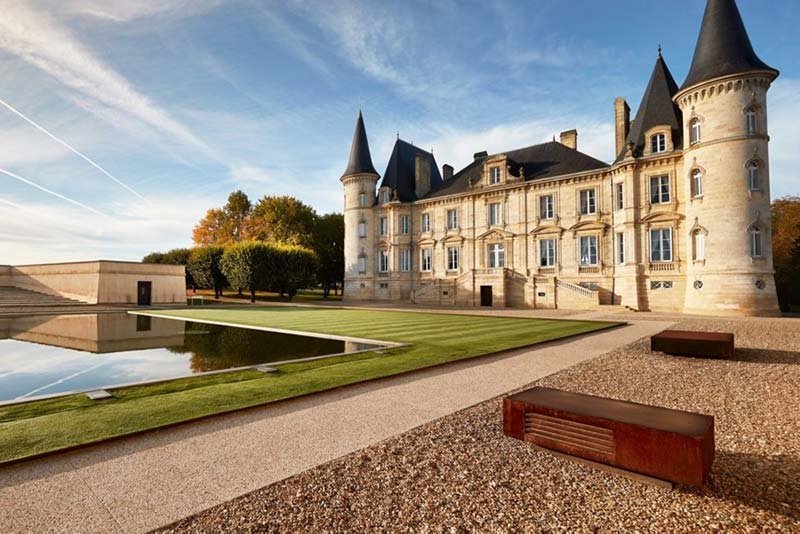
The Pichon Longueville estates are part of the Pauillac Appellation on the left bank of the Gironde Estuary in the Medoc wine region. They’re situated facing each other along Bordeaux’s Route des Châteaux highway.
The Pauillac appellation is also home to three of the five first-growths (premier cru) estates in the Bordeaux classification - Chateau Latour, Lafite, and Mouton Rothschild.
Both Chateau Baron and Pichon Lalande are known for their exceptional Bordeaux wines. However, their wine styles differ from each other and offer unique expressions of the classic Bordeaux terroir.
The Chateau Pichon Baron estate is currently owned and run by the AXA Millesimes (since 1987), with Christian Seely (Managing Director) at the helm.
On the other hand, the Chateau Pichon Lalande estate is owned and managed (since 2007) by the Rouzaud family (owner of Champagne house Louis Roederer).
So, what’s the story behind these iconic wineries?
History Of Chateau Pichon Longueville At A Glance

The wine merchant Pierre de Rauzan established the original property in 1689. At the time, he also managed Chateau Latour and Chateau Margaux.
After Rauzan’s death, his daughter Therese inherited the property. It was officially named Chateau Pichon-Longueville after she married Jacques de Pichon Longueville in 1694.
In 1850, Baron Joseph de Pichon Longueville, the then-owner of the estate, divided the property among his children. His son Baron Raoul Pichon de Longueville inherited the part that we today refer to as Chateau Pichon-Longueville Baron.
Joseph’s daughter, Virginie, took ownership of the other part. She married Count Henri de Lalande and renamed her part of the property Chateau Pichon-Longueville Comtesse de Lalande.
The imposing Chateau Baron and Chateau Lalande were commissioned in 1851 and 1841, respectively.
Let’s take a look at the terroir and vineyard sites at Pichon Longueville.
Chateau Pichon Longueville Terroir And Vineyards
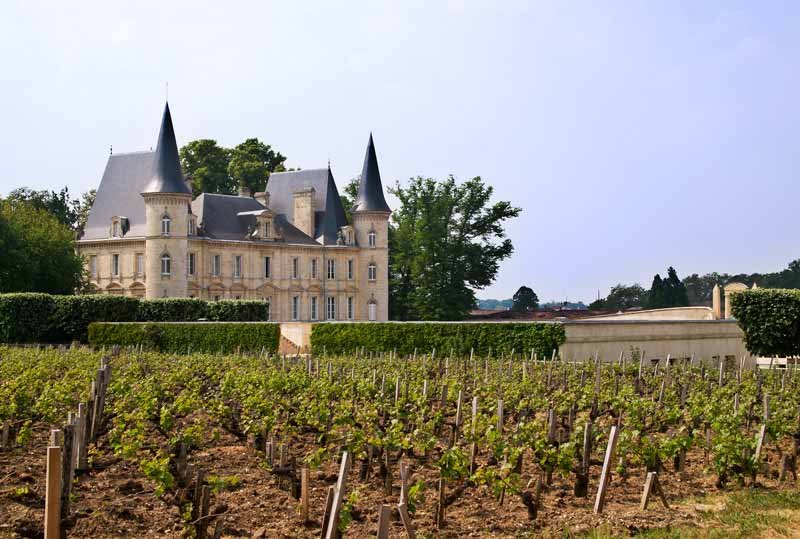
Both Pichon Longueville estates enjoy a similar terroir:
- Gravelly soil for optimum drainage
- Clay and limestone subsoil for deep nutrient absorption
- Suitable maritime climate
- Strategic location between the Gironde River and the Atlantic Ocean
The 72 hectares of vineyards at the Pichon Baron estate comprise 65% Cabernet Sauvignon, 30% Merlot, 3% Cabernet Franc and 2% Petit Verdot grape vines. Each grape variety is meticulously planted in separate plots to ensure optimum growing conditions.
The grapes for the Grand Vin are harvested from the ‘Butte de Pichon Baron’ parcel that offers the best terroir of all.
The Pichon Lalande estate has more than doubled its vineyard size from 40 hectares to 89 hectares in the last few decades. Around 12 hectares of vine plantation spills into the neighboring Saint Julien region.
The estate comprises six main vineyard blocks currently planted with 61% Cabernet Sauvignon, 32% Merlot, 4% Cabernet Franc and 3% Petit Verdot.
In 2012, the estate began replanting its vineyard plots to ensure each grape variety is planted in its ideal terroir.
Both the Pichon and Lalande estates are committed to sustainable farming, focusing on organic and biodynamic viticulture.
Winemaking At Chateau Pichon-Longueville Estates
Let’s take a quick look at the winemaking processes at the two wineries:
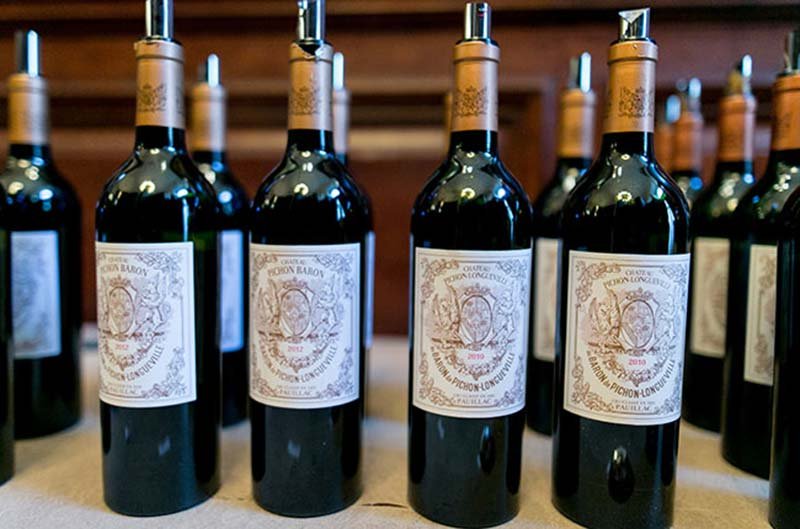
1. Winemaking At Chateau Pichon Baron
After careful selection through optical sorting, the grapes undergo maceration for 20-30 days.
They are then transferred to temperature-controlled steel vats for fermentation at 28-32 °C.
After the malolactic fermentation is complete, the wine is transferred to new oak barrels to age for around 12-20 months.
Racking is done every three-four months to free the wine from lees.
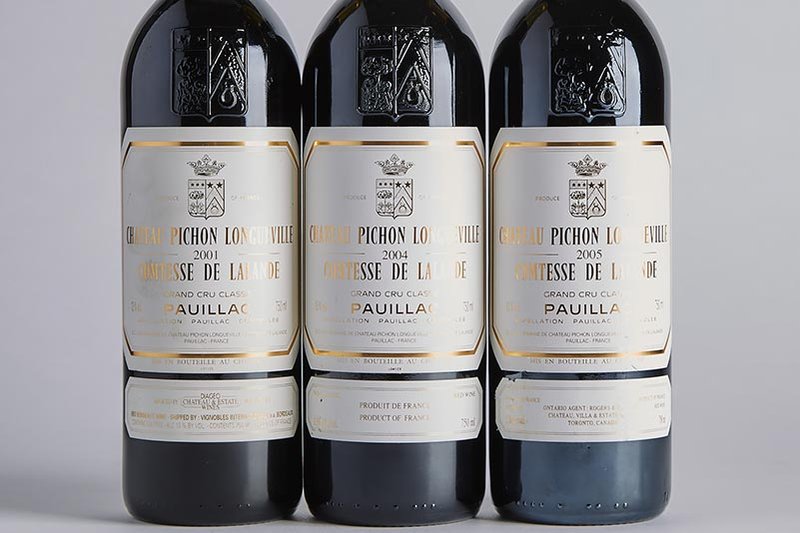
2. Winemaking At Chateau Pichon Lalande
After a rigorous hand sorting, the grapes are left to ferment in heat-regulated steel vats for 18-25 days.
The wine also gets pumped over (rémontage), where the clear grape juice at the bottom of the tank gets mixed with the cap (skin, seeds, and stem) at the top. This process gives the wine its rich deep color by extracting the phenolic content.
Once malolactic fermentation is complete, the wine is transferred to 50% new French oak barrels to age for around 18 months.
Contrasting Wine Styles Of Pichon Longueville Wineries

The two Pichon Longueville estates have had a rich, long history of producing clarets with exceptional finesse and elegance.
The Pichon Baron estate is known for its robust and masculine Bordeaux wines that strike a fine balance between power and refinement.
The three Pichon Baron wines are:
- Le Grand Vin de Chateau Pichon Longueville Baron: A robust blend of Cabernet Sauvignon and Merlot, the Grand Vin is a complex, full-bodied, and tannic wine that can age for over forty years.
- Les Tourelles de Longueville: This Pauillac wine is potent yet masterful blend of Merlot, Cabernet Sauvignon, Cabernet Franc, and Petit Verdot.
- Les Griffons de Pichon Baron: Described by the estate as a wine with a ‘pure and direct character,’ this second label is made from Cabernet Sauvignon and Merlot.
On the other hand, the PichonLalande estate offers a more feminine take on the classic Bordeaux style. The sensuous quality of the wine is often credited to the use of large portions of Merlot in the blend.
Here’s a breakdown of the two Lalande wines:
- Chateau Pichon Longueville Comtesse de Lalande: The highly-coveted Grand Vin is a full-bodied and intense blend of Cabernet Sauvignon, Merlot, and Cabernet Franc with a reputation of aging for up to 40 years or more.
- Pichon Comtesse Reserve (Réserve de la Comtesse): This great wine is made from a varying mix of Cabernet Sauvignon, Merlot, Petit Verdot, and Cabernet Franc.
Let’s explore some exceptional vintages from the two Pichon wineries.
The Best Vintages from Chateau Pichon Longueville Estates In 2024
Here’s our selection of the most outstanding Pichon wines in 2024:
1. 1961 Chateau Pichon-Longueville au Baron de Pichon-Longueville

This old-school Bordeaux is rich and intense with inviting aromas of dark fruit and chocolate covered cherries.
The palate is juicy with grippy tannin and notes of plum, cassis, baking spices, and tobacco leaf.
The price of 1961 Chateau Pichon-Longueville au Baron de Pichon Longueville: $862
2. 1989 Chateau Pichon-Longueville au Baron de Pichon-Longueville

The deep ruby red wine will entice you with notes of tobacco, ripe cassis, and earth.
The palate is deeply layered with flavors of blackberry, smoke, and silky tannins.
You can enjoy this Pauillac vintage now or age it in the cellar for another 8-10 years.
The price of 1989 Chateau Pichon-Longueville au Baron de Pichon Longueville: $337
3. 1989 Chateau Pichon-Longueville Baron Les Tourelles de Longueville

This impressive second wine from the Baron estate is a classic Bordeaux blend of Merlot, Cabernet Sauvignon, Cabernet Franc,and Petit Verdot.
The garnet-purple wine welcomes you with fragrant notes of cassis and baking spices.
The medium-bodied palate offers well-rounded tannins and flavors of dark plum, red currant, leather, and mushrooms.
The price of 1989 Chateau Pichon-Longueville Baron Les Tourelles de Longueville: $155
4. 2016 Chateau Pichon-Longueville 'Les Griffons de Pichon Baron'
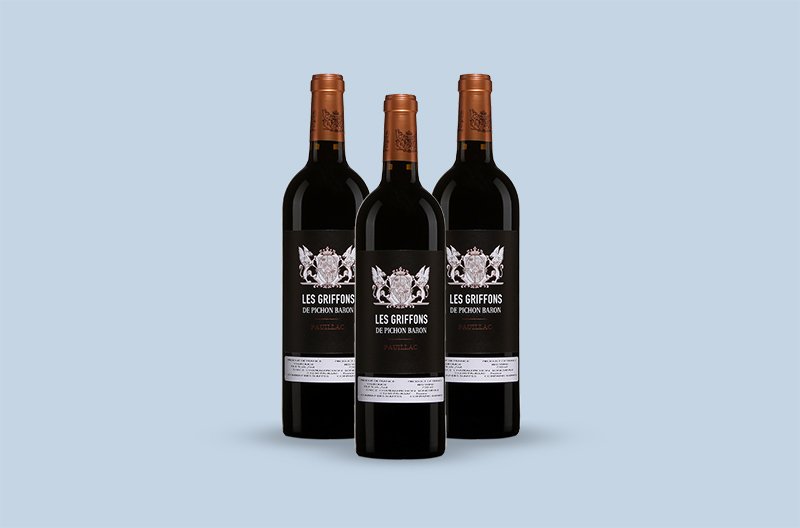
The stellar second wine is inky-purple and opens with aromas of lavender and tar.
The palate is plush with moderate acidity and luscious tannin. Dominant tasting notes are black currant, black cherry, minerals, and herbs.
The price of 2016 Chateau Pichon-Longueville 'Les Griffons de Pichon Baron': $67
5. 1982 Chateau Pichon Longueville Comtesse de Lalande

Opulent, sensuous, refined, and complex are words that describe this remarkable vintage.
The nose opens with the sweet aromas of rich dark fruits. On the palate, it hits you with intense flavors of blackcurrants, cassis, and cocoa. A long and rich finish complements the silky tannins.
The price of 1982 Chateau Pichon Longueville Comtesse de Lalande: $940
6. 2000 Chateau Pichon Longueville Comtesse de Lalande
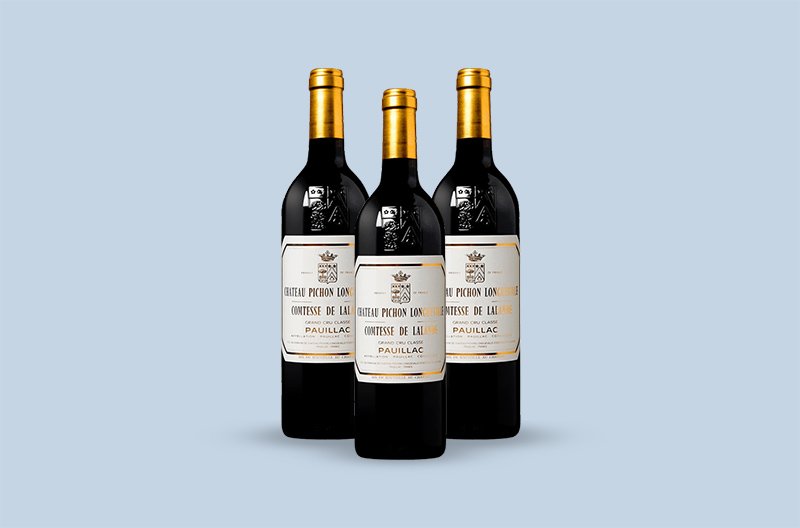
This sensual Bordeaux blend has an opulent nose of red and black fruit. On the palate, it has dominant flavors of dark berries, truffle, cassis, and spice. The palate is velvety and supple with silky tannin and a fresh aftertaste.
The great wine may show even more complexity after 5-10 years of aging in the cellar.
The price of 2000 Chateau Pichon Longueville Comtesse de Lalande: $380
7. 1996 Chateau Pichon Longueville Comtesse de Lalande 'Pichon Comtesse Reserve'
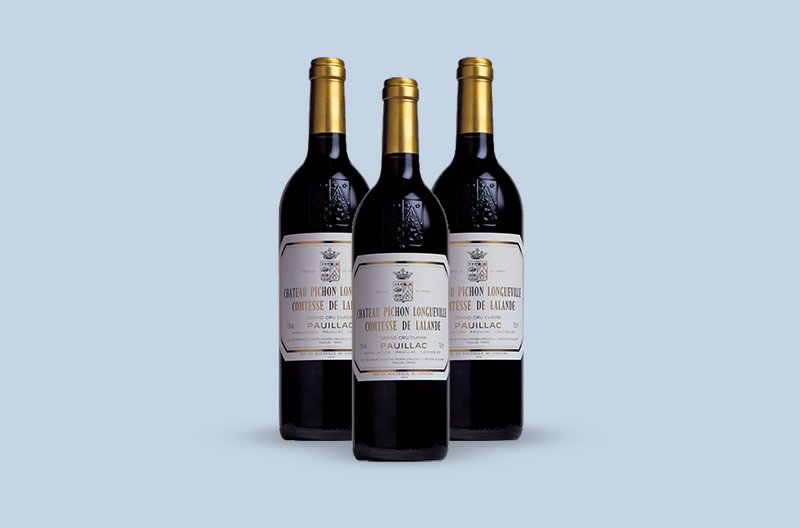
The ruby-colored second wine gives off initial whiffs of cedar, tobacco, and leather. The palate is structured with fine tannins and moderate acidity.
The tasting notes include dark fruit, red currant, licorice, and cassis.
The price of 1996 Chateau Pichon Longueville Comtesse de Lalande 'Pichon Comtesse Reserve': $284
8. 2001 Chateau Pichon Longueville Comtesse de Lalande 'Pichon Comtesse Reserve'
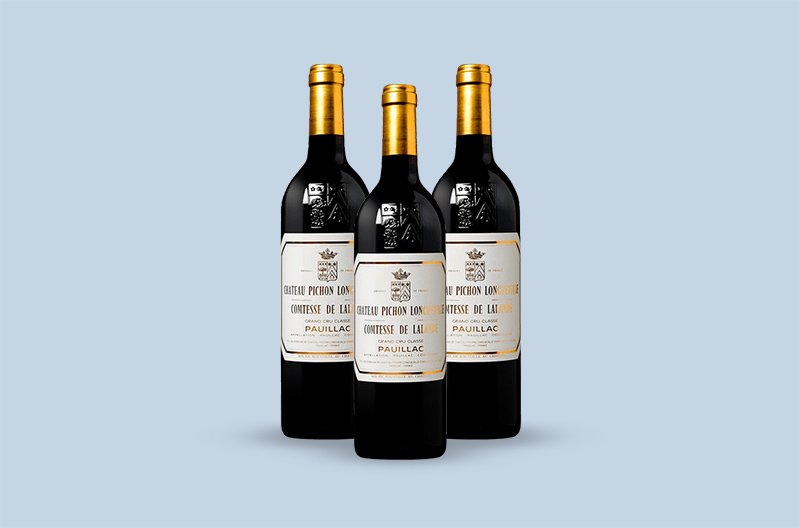
True to the Lalande heritage, the 2001 vintage is all about elegance and complexity.
The nose opens with an opulent aroma of chocolate covered cherries. The palate is full-bodied with notes of dark fruit, graphite, tea, and leather. The wine offers silky tannins and a long, savory finish.
The Price of 2001 Chateau Pichon Longueville Comtesse de Lalande 'Pichon Comtesse Reserve': $197
Now let’s explore the investment-worthiness of Chateau Pichon Longueville wines.
Should You Invest In Chateau Pichon Longueville Wines?
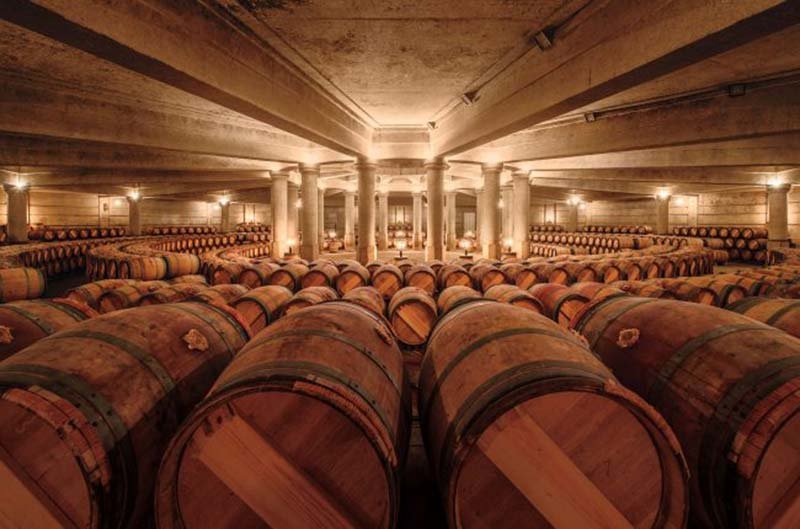
The second growth vintages from the two Pichon Longueville estates are a favorite among wine connoisseurs and investors.
The two Grand Vins are often lauded for matching first-growth wines from the Bordeaux region. They’re often termed “super second” or “nearly first” wines and are very popular at en primeur campaigns.
They also age incredibly well, reaching their peak in 15-50 years after the vintage.
Their vintages (Millésimes) are among the highest-rated Pauillac wines and command impressive prices at auctions.
- The 1959 Chateau Pichon-Longueville, Lalande had fetched over $ 2,560 for a lot of 12 bottles during a 2014 auction at Christie’s.
- At a 2018 auction at Sotheby’s, a collection (34 bottles of various sizes like magnum, Jeroboam, and Melchior) of 2010 Chateau Pichon Baron was sold for a whopping $30,884.
Today the Lalande Grand Vin commands an average price of $216, a 17% increase from its 2020 price ($184). Similarly, the Baron estate Grand Vin averages around $192 per bottle, a 17% growth from $162 in 2020.
Raring to get a Pichon-Longueville bottle for your collection already?
Vinovest can help you buy an authentic bottle of Pichon-Longueville and other collectible wines from the comfort of your home.
Buy Authentic Chateau Pichon Longueville And Other Fine Wines Through Vinovest

Vinovest is a wine investment company that helps you build a portfolio of rare investment-worthy wines, without having to be a wine expert.
How Does It Work?
Get started with these five simple steps:
- Sign up on the Vinovest website with your name, email, and password.
- Fill out a questionnaire to share your investment preferences and risk appetite.
- Fund your account with a minimum of $1,000.
- Grow your wine portfolio with personalized wine suggestions from Vinovest.
The Benefits Of Investing through Vinovest
Here are some key benefits of using Vinovest:
1. Buy And Sell Wines Using AI-Driven Technology
Vinovest’s AI-based platform allows you to buy and sell fine wines from the comfort of your home with just a few clicks.
2. Authenticity
The Vinovest team goes the extra mile to trace your wine’s provenance, so you don’t have to worry about getting a counterfeit bottle ever again.
3. Get The Best Prices
When you buy a bottle of wine through Vinovest, rest assured that you pay a fair price without any markups. Vinovest sources your wines directly from the winemaker, merchants, or wine exchanges at wholesale prices.
4. Curated Portfolio by an Expert Wine Advisory Team
You don’t need to be an expert to create a profitable wine portfolio. The Vinovest team uses historical data and proprietary financial models to help you pick high-performing wines.
5. Optimal Storage
Vinovest stores your wines in world-class wine storage facilities in France, the UK, Switzerland, and other global wine industry hotspots.
Also, these warehouses maintain perfect light, temperature, vibration, and humidity conditions. There are power back-ups in case the primary method fails to maintain perfect climate control.
6. Comprehensive Insurance and Security
With Vinovest, your wines are in safe hands. All your bottles are monitored 24/7 by security cameras.
It also offers a full insurance policy at market value, protecting each bottle against breakage, theft, and loss.
7. Low Overall Costs and Tax Benefits
Vinovest charges a minimal annual fee of 2.5% (or 1.9% for a portfolio of above $50,000.)
This fee includes wine buying, selling, and storage costs, as well as authentication, insurance, and portfolio management.
You also enjoy significant tax advantages as the bonded storage facilities don’t charge excise duty or VAT.
8. Easy Delivery
Vinovest ensures that your wine gets safely and timely delivered for your enjoyment. If you choose to sell it for a profit, it’ll get delivered to a counterparty buyer anywhere in the world.
Chateau Pichon Longueville: Investment Worthy Bordeaux Wines With A Great Heritage

The Pichon Baron and Pichon Lalande wineries have masterfully combined centuries of winemaking experience with modern technology.
The result is the continuing success of their Deuxieme Grand Cru Classe wines and the rising popularity of their second wines.
These wines are not just a treat for your senses but also an excellent investment option.
Vinovest gives you the ultimate platform to maximize profits by investing in such fine wines. So, why notsign up today and start adding them to your portfolio?
